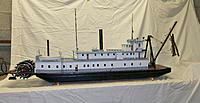- Joined
- Mar 1, 2010
- Messages
- 866
- Reaction score
- 82
Pete
Yes it is a bit messy but you'll also have appreciated how much better the engine sounds on steam.
It would seem to be too much oil, but in these early days too much is better than too little while everything gets bedded in. Its not like the engine is doing any appreciable work either.
I'd suggest that checking for scored bores is a bit late in the process. You're hoping not to get any scores in the bores.
Pete
Yes it is a bit messy but you'll also have appreciated how much better the engine sounds on steam.
It would seem to be too much oil, but in these early days too much is better than too little while everything gets bedded in. Its not like the engine is doing any appreciable work either.
I'd suggest that checking for scored bores is a bit late in the process. You're hoping not to get any scores in the bores.
Pete





















































![DreamPlan Home Design and Landscaping Software Free for Windows [PC Download]](https://m.media-amazon.com/images/I/51kvZH2dVLL._SL500_.jpg)






































































